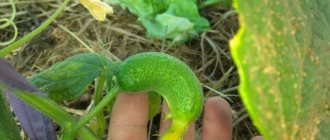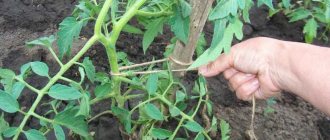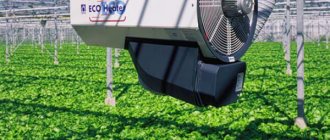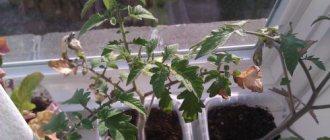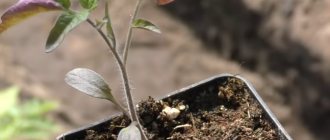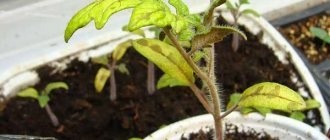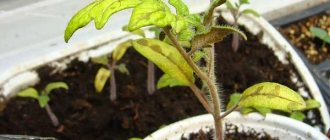Growing tomatoes is not an easy task. It takes a lot of effort to enjoy these delicious vegetables in the summer. Problems can occur at any stage of growing tomatoes.
The tomato is a capricious one. He doesn’t like it, it doesn’t suit him. One causes the ovary to fall off, another causes the leaves to curl, and the third causes spots to appear.
- Determinant of tomato diseases: photos, descriptions, control measures and prevention
Are the tomato leaves turning black and brown spots visible on the fruits? Find out what diseases could cause these and other symptoms!
But even if all these diseases and misfortunes were avoided, and all your tomatoes as one are healthy, handsome, do not rush to breathe a sigh of relief. Healthy ripening tomatoes also have problems. One of the most common is fruit cracking.
The danger of cracks in tomatoes
The cracks themselves have a cosmetic defect, which makes them unsuitable for mass sale. In addition, they are not suitable for preservation, since when exposed to boiling water, the skin will be removed and the pulp will boil. But these shortcomings are only half the story.
The main danger is that cracks in tomatoes serve as entry points for various infections.
Once inside the vegetable, pathogenic microorganisms cause the active development of the disease. The fruits rot from the inside. These tomatoes are not suitable for human consumption.
If the peel begins to burst, this indicates a violation of the process of growing the crop, and if the influence of unfavorable factors is not removed, then fungal, viral or bacterial infections will join the harmless cracks.
Common mistakes
Now let's talk about the most common mistakes that gardeners make when trying to “cure” tomatoes from cracking.
Most often, having noticed cracks, the summer resident begins to water the plants even more intensely. This only makes the problem worse.
The second common mistake is improper feeding. The plant does not need nitrogen and phosphorus fertilizers during fruiting. But tomatoes will like potassium. Also, tomatoes often lack boron.
Well, the third common mistake is ignoring the problem.
In principle, you can ignore cracked tomatoes if you grow them for yourself.
But in general, this disease affects the harvest, because the cracked part is usually cut off. As a result, up to a third of the fruit is thrown away.
Types of cracking
If you carefully examine the defects on the tomatoes, you can see that they are different.
Therefore, there are several types of cracking.
Radial
The formation of cracks in the stalk, which radiate in different directions.
Causes:
- temperature changes;
- insufficient watering with periods of increased soil moisture;
- varietal feature;
- boron deficiency.
Concentric cracking
Cracks form at the stalk and spread throughout the vegetable in the form of circles and semicircles.
Causes:
- the use of large amounts of nitrogen-containing fertilizers;
- water balance disturbances;
- feature of some varieties.
Mesh
The formation of a net-like pattern at the top of the tomato due to the separation of the pericarb (layer under the skin). It differs at the stage of fruit formation, while they are still green.
Causes:
- injury to the flower during flowering;
- cold snap during the formation of buds and ovaries;
- high nitrogen content in the soil or excess calcium with a lack of potassium.
More often found in large-fruited varieties.
The safest type of cracks, since the damage is microscopic in size and is characterized by rapid scarring.
In the greenhouse during ripening
Most often, tomatoes crack when grown in greenhouses.
There are several unfavorable factors that contribute to fruit damage.
Incorrect temperature conditions (microclimate disturbances)
Normal fruit development occurs at temperatures from 22 to 25°C. Maintaining this temperature without additional effort is not always possible.
Growing conditions as a cause of cracks
A crack in a tomato hanging on a bush is the main signal that the crop is not being grown correctly. Destruction of the skin occurs due to unsuitable conditions for vegetation and plant growth. Along with the tomato, the stem of the plant may also crack. To determine the reason why a tomato is cracking, it is necessary to check whether there are any errors in the growing methods used. Most often, farmers make mistakes in the basic procedures for caring for the crop: watering, fertilizing, suitable temperature and light conditions, non-compliance with the peculiarities of growing the variety.
In open ground when ripe
Tomatoes growing in open ground are also susceptible to adverse factors that lead to cracks.
Many problems are identical to greenhouse conditions: varietal characteristics, improper watering, lack of chemicals and improper use of fertilizers.
However, there are also some peculiarities. Reasons that cause cracking in tomatoes only in open ground.
Temperature changes
At night, the temperature drops sharply, which leads to the accumulation of moisture in the fruits due to reduced evaporation.
This leads to increased stress on the tomato epidermis and the formation of skin defects. If you water after sunset, this effect can be avoided.
Abundant hydration during rains
It is not always possible to guess the combination of watering and rain. Sometimes these two processes follow each other. Then excess moisture forms in the soil, which quickly accumulates in the tomatoes, causing them to crack.
To prevent this, it is recommended to organize a watering schedule and use mulching, as well as monitor the weather forecast.
Why do green fruits burst?
Most often, cracks on green tomatoes indicate improper care.
Everything that was said above is true not only for red ripe tomatoes, but also for green fruits.
Improper watering, excess or lack of fertilizers, heat and temperature changes cause first a slowdown and then a sharp growth of fruits. The tomato skin cannot stand it and begins to crack.
Tomato diseases
If all the conditions for growing tomatoes are met, but the fruits continue to deteriorate and an increasing number of bushes become infected, then it is worth thinking about the presence of specific diseases.
Alternaria "dry spotting"
Fungal infection of tomatoes, which is characterized by the appearance of dry spots on fruits and leaves.
On tomatoes, the spots look like overgrown cracks, but over time the disease progresses, affecting most of the foliage and leading to its death.
Fungicides are used to eliminate fungi. If treatment does not help, the plant should be removed to prevent infection of other crops.
Apical rot
Appears on green fruits. Unripe tomatoes begin to rot from the top. Usually the entire fetus is not affected. The disease is caused by a lack of calcium.
Gray rot
A fungal infection that causes rotting of standing tomatoes. Affects stems, leaves and fruits. Develops in conditions of high humidity. The spots have a dark gray tint.
What needs to be done to prevent green and red tomatoes from bursting on the bushes: a set of measures, tips
The main thing is not to dramatically change the growing conditions.
Preservation measures for greenhouse tomatoes
- Choose the right variety. These should be soft varieties: Nasha Masha, Ostrich, Diva, Centaur, Harlequin, Beautiful Lady, Podmoskovny, Favorite, etc. These varieties are less susceptible to cracking because they have thicker skins.
- In the early period, right up to the beginning of mass ripening, when the crown and root system are formed, it is necessary to maintain regularity and uniformity of watering. Avoid overdrying or waterlogging the soil, especially abruptly.
- In summer, the roof of a greenhouse made of glass or polycarbonate must be treated from the outside with lime milk. This measure will reduce the temperature in the greenhouse, which will reduce the rate of moisture transfer. Shading can also be provided by covering the greenhouse with a special mesh or agrofibre.
- During very high temperatures, all greenhouse doors should be open. In windy weather - a side wall located on the leeward side.
- If drying out is allowed, do not fill it with a large amount of water at once. Watering should be done in small portions in several stages to prevent sudden cell growth.
- If the temperature at night drops below 13°C, then watering can be done no earlier than noon the next day. In hot weather, watering is only permissible in the evening.
- Bushes with mostly ripe fruits are not recommended to be watered abundantly. Such plants already have a powerful root system and draw moisture from deep layers. It is advisable to water such bushes locally, directly at the root, every 5 days.
- It is advisable to take concentrated fertilizers at the rate of 20 g per 10 liters of water. This amount will feed the plant, but will not lead to cracking.
- If the leaves turn yellow or curl, watering should be reduced.
Tomatoes in a greenhouse
Measures for preserving tomatoes in open ground
- Choose varieties designed for growing outdoors.
- Control your moisture balance. The early period of maturation is the most significant. It is necessary to regularly check the degree of importance: dig a hole 10 cm deep. If the soil is wet, you can form a lump, but with light pressure it easily crumbles, then the humidity is good.
- At the beginning of ripening, the soil should have average moisture - about 50%. The more ripe the fruits become, the less watering is needed.
- If the soil is very dry, watering should be gradual, in several stages. A large volume of water will immediately lead to cracking.
- The crown of the bush should be sufficient and prevent direct sunlight from reaching the fruit. It is necessary to promptly protect plants from pests and diseases. If the sun is very active, it is advisable to darken the area, otherwise burns will appear on the leaves and fruits.
- Mulching can be used to maintain moisture at a constant level.
- Control the balance of microelements.
- Dilute concentrated fertilizers with sufficient water.
Lack of microelements affects not only the leaves
Signs of micronutrient deficiency
Lack of microelements can also cause cracking. If the temperature and moisture conditions are normal, pay attention to the appearance of the plants; there may be a deficiency of microelements:
- A lack of nitrogen leads to short stature of plants and rapid ripening of fruits that have not reached their standard size. At the same time, old leaves become lighter.
- Lack of phosphorus also reduces bush growth. Small leaves have a purple tint, their edges are deformed - curved. Gradually the leaves die and fall off.
- Potassium deficiency can be identified by the burnt edges of old leaves. Gradually this process will move to younger leaves. The fruit will have black stripes.
- Calcium deficiency manifests itself as spotty yellowing on deformed leaves. Gradually the dots merge and the leaf dies.
- Copper deficiency is often observed in peaty soils. The leaves appear white. The shoots become weak, the young leaves become small, the flowers develop poorly and fall off.
- With a lack of boron, stepsons stop forming and growth points die off. Dried areas are observed on the fruits.
- Magnesium deficiency is characterized by the appearance of yellow-green spots on the leaves, which gradually turn gray or brown. The leaves dry out and fall off, the fruits ripen at an accelerated rate, so they remain small.
By following these recommendations, you can prevent cracking and get a full, healthy harvest.
How to avoid cracking tomatoes
To maintain the health of vegetable crops, you should follow a few simple rules:
- Clean the greenhouse in the autumn. It includes removing old leaves and fruits, digging up the soil, and applying preventative medications and fertilizers.
- Do not plant tomatoes and plants of the Solanaceae family nearby. Particularly dangerous is the proximity of tomatoes to potatoes, since the latter is often a source of diseases that quickly affect the vegetable crop.
- Drugs for treating tomato diseases should be used strictly according to the instructions and in the indicated dosages.
- Organize regular watering. On hot days, the schedule is 1 time every 3 days, in cloudy weather - 1 time a week. The best option is to organize drip irrigation.
- Using mulching to protect the soil. Straw or grass clippings will do.
- Regularly ventilate the greenhouse and maintain its temperature.
- Choose varieties that are resistant to cracking (more on this later).
Advice from experienced agronomists
In addition to the recommendations above, there are a few more tips that will help prevent cracking .
- Ventilation . Remember to ventilate the greenhouse to even out the temperature and give the plants fresh air.
- Gradual watering . The best option would be not to immediately pour out the entire volume of water intended for it, but to divide the watering into two stages. Pour out half the volume, wait until the water is absorbed, and only then pour out the second half. Then moisture absorption will be more uniform.
If all conditions are met, it is possible, if not to avoid the appearance of cracks, to significantly reduce the likelihood of their occurrence.
Calcium and boron against cracking of tomatoes
Not many people know, but these two fertilizers only work when used together, since calcium absorption does not occur without boron.
To reduce cracking of tomatoes, it is recommended to add calcium nitrate with boric acid to the soil. Such a cocktail will not only protect the plants and have a stimulating effect on the processes of growth and ripening of fruits.
Varieties not prone to cracking
When choosing a tomato variety, it is necessary to take into account their resistance to cracking. The corresponding mark is placed on the package with ready-made seeds. Varieties have dense pulp and elastic skin.
Most popular:
- Hybrid Boheme - Large tomatoes with a long shelf life and resistance to transportation.
- Asteroid – Dense, ideal for pickling. They are characterized by increased resistance to the effects of diseases and adverse factors.
- Lady fingers – Small, dense, pear-shaped fruits.
- Grushovka – A red variety with an elongated shape, with a long shelf life.
- Pink Honey – Large, kidney-shaped tomatoes.
- Raspberry Viscount - A low-growing, unpretentious variety that does not require special care.
- Rio Grande - Differs in drought resistance, have a plum-shaped form.
- Hybrid Vladimir – Resistant variety with dense fruits.
- Khutorskoy salting – A variety with a long period of ripening and storage (up to 5 months).
Khutorsky salting
Other Possible Causes
Caring for tomato plants requires understanding a few simple principles. For example, this vegetable crop needs a sufficient amount of moisture. Therefore, it is very important to regularly moisten the soil in the places where they grow. Prolonged drought will inevitably lead to a stunting of tomato growth.
Important! Despite the fact that such vegetables need abundant watering, you should not oversaturate them with moisture either. If you make such a mistake, the pulp will develop too actively, which will lead to the appearance of tears in the peel. If your tomatoes burst, then first of all reconsider the technology for growing them.
Cracks also appear on unripe fruits. Rain can ruin the harvest, so a conscientious summer resident should take care to protect his tomatoes from moisture. You can save the bushes with the help of homemade canopies that are installed on the beds. You can choose ordinary polyethylene film as a covering material to protect plants. But the service life of such a canopy does not exceed 3 years.
Greenhouse
The best solution, recommended by many experienced gardeners, is lutrasil. This material has a longer service life, exceeding 7 years. Lutrasil will protect tomato bushes not only from heavy rains, but also from the scorching sun.
If the tomatoes are cracking, then the problem may lie in temperature fluctuations, which have an adverse effect on the bushes. Another factor leading to crop failure is the procedure of pinching the top. The popularity of this procedure is due to the fact that a bush formed in this way promotes unnatural growth of tomatoes. As a result, the peel cannot withstand the pressure and bursts. Pinching should only be done on tall varieties of tomatoes.
Excessive feeding of bushes with fertilizers can also cause cracks in vegetables. Therefore, when feeding plants, you should always observe moderation. And finally, some varieties are genetically prone to cracking. When choosing seeds, it is necessary to give preference to those varieties that maintain their integrity even in difficult conditions.
Interesting: Eggplants in a greenhouse: diseases and treatment
What else can you do with tomatoes if they have already begun to spoil?
If there are a lot of tomatoes with defects, and you can’t simply eat them, then you can use them to prepare various dishes:
- Tomato sauce - when preparing it, the peel and defects are removed, and the remaining pulp is heat treated.
- Tomato paste – prepared from tomatoes by baking them.
- Tomato oil - ripe vegetables are baked, the peel is removed, spices and herbs are added and everything is mixed with butter.
- Salad dressing – mix ripe tomato juice with vinegar and spices.
- Freeze - remove defects, cut into cubes or slices and blast freeze.
Compliance with agricultural technology, timely and rational application of fertilizers and disease prevention help preserve tomatoes in marketable condition and be used for various purposes without restrictions.
How do you deal with cracking tomatoes? Share your experience in the comments.


